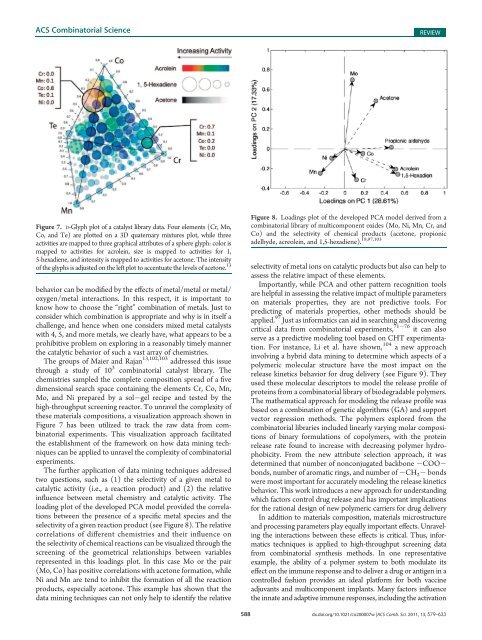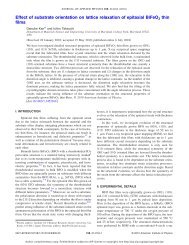Combinatorial and High-Throughput Screening of Materials ...
Combinatorial and High-Throughput Screening of Materials ...
Combinatorial and High-Throughput Screening of Materials ...
Create successful ePaper yourself
Turn your PDF publications into a flip-book with our unique Google optimized e-Paper software.
ACS <strong>Combinatorial</strong> Science<br />
REVIEW<br />
Figure 7. D-Glyph plot <strong>of</strong> a catalyst library data. Four elements (Cr, Mn,<br />
Co, <strong>and</strong> Te) are plotted on a 3D quaternary mixtures plot, while three<br />
activities are mapped to three graphical attributes <strong>of</strong> a sphere glyph: color is<br />
mapped to activities for acrolein, size is mapped to activities for 1,<br />
5-hexadiene, <strong>and</strong> intensity is mapped to activities for acetone. The intensity<br />
<strong>of</strong> the glyphs is adjusted on the left plot to accentuate the levels <strong>of</strong> acetone. 13<br />
behavior can be modified by the effects <strong>of</strong> metal/metal or metal/<br />
oxygen/metal interactions. In this respect, it is important to<br />
know how to choose the “right” combination <strong>of</strong> metals. Just to<br />
consider which combination is appropriate <strong>and</strong> why is in itself a<br />
challenge, <strong>and</strong> hence when one considers mixed metal catalysts<br />
with 4, 5, <strong>and</strong> more metals, we clearly have, what appears to be a<br />
prohibitive problem on exploring in a reasonably timely manner<br />
the catalytic behavior <strong>of</strong> such a vast array <strong>of</strong> chemistries.<br />
The groups <strong>of</strong> Maier <strong>and</strong> Rajan 13,102,103 addressed this issue<br />
through a study <strong>of</strong> 10 3 combinatorial catalyst library. The<br />
chemistries sampled the complete composition spread <strong>of</strong> a five<br />
dimensional search space containing the elements Cr, Co, Mn,<br />
Mo, <strong>and</strong> Ni prepared by a sol gel recipe <strong>and</strong> tested by the<br />
high-throughput screening reactor. To unravel the complexity <strong>of</strong><br />
these materials compositions, a visualization approach shown in<br />
Figure 7 has been utilized to track the raw data from combinatorial<br />
experiments. This visualization approach facilitated<br />
the establishment <strong>of</strong> the framework on how data mining techniques<br />
can be applied to unravel the complexity <strong>of</strong> combinatorial<br />
experiments.<br />
The further application <strong>of</strong> data mining techniques addressed<br />
two questions, such as (1) the selectivity <strong>of</strong> a given metal to<br />
catalytic activity (i.e., a reaction product) <strong>and</strong> (2) the relative<br />
influence between metal chemistry <strong>and</strong> catalytic activity. The<br />
loading plot <strong>of</strong> the developed PCA model provided the correlations<br />
between the presence <strong>of</strong> a specific metal species <strong>and</strong> the<br />
selectivity <strong>of</strong> a given reaction product (see Figure 8). The relative<br />
correlations <strong>of</strong> different chemistries <strong>and</strong> their influence on<br />
the selectivity <strong>of</strong> chemical reactions can be visualized through the<br />
screening <strong>of</strong> the geometrical relationships between variables<br />
represented in this loadings plot. In this case Mo or the pair<br />
(Mo, Co) has positive correlations with acetone formation, while<br />
Ni <strong>and</strong> Mn are tend to inhibit the formation <strong>of</strong> all the reaction<br />
products, especially acetone. This example has shown that the<br />
data mining techniques can not only help to identify the relative<br />
Figure 8. Loadings plot <strong>of</strong> the developed PCA model derived from a<br />
combinatorial library <strong>of</strong> multicomponent oxides (Mo, Ni, Mn, Cr, <strong>and</strong><br />
Co) <strong>and</strong> the selectivity <strong>of</strong> chemical products (acetone, propionic<br />
adelhyde, acreolein, <strong>and</strong> 1,5-hexadiene). 18,97,103<br />
selectivity <strong>of</strong> metal ions on catalytic products but also can help to<br />
assess the relative impact <strong>of</strong> these elements.<br />
Importantly, while PCA <strong>and</strong> other pattern recognition tools<br />
are helpful in assessing the relative impact <strong>of</strong> multiple parameters<br />
on materials properties, they are not predictive tools. For<br />
predicting <strong>of</strong> materials properties, other methods should be<br />
applied. 97 Just as informatics can aid in searching <strong>and</strong> discovering<br />
critical data from combinatorial experiments, 71 76 it can also<br />
serve as a predictive modeling tool based on CHT experimentation.<br />
For instance, Li et al. have shown, 104 a new approach<br />
involving a hybrid data mining to determine which aspects <strong>of</strong> a<br />
polymeric molecular structure have the most impact on the<br />
release kinetics behavior for drug delivery (see Figure 9). They<br />
used these molecular descriptors to model the release pr<strong>of</strong>ile <strong>of</strong><br />
proteins from a combinatorial library <strong>of</strong> biodegradable polymers.<br />
The mathematical approach for modeling the release pr<strong>of</strong>ile was<br />
based on a combination <strong>of</strong> genetic algorithms (GA) <strong>and</strong> support<br />
vector regression methods. The polymers explored from the<br />
combinatorial libraries included linearly varying molar compositions<br />
<strong>of</strong> binary formulations <strong>of</strong> copolymers, with the protein<br />
release rate found to increase with decreasing polymer hydrophobicity.<br />
From the new attribute selection approach, it was<br />
determined that number <strong>of</strong> nonconjugated backbone COO<br />
bonds, number <strong>of</strong> aromatic rings, <strong>and</strong> number <strong>of</strong> CH 2 bonds<br />
were most important for accurately modeling the release kinetics<br />
behavior. This work introduces a new approach for underst<strong>and</strong>ing<br />
which factors control drug release <strong>and</strong> has important implications<br />
for the rational design <strong>of</strong> new polymeric carriers for drug delivery<br />
In addition to materials composition, materials microstructure<br />
<strong>and</strong> processing parameters play equally important effects. Unraveling<br />
the interactions between these effects is critical. Thus, informatics<br />
techniques is applied to high-throughput screening data<br />
from combinatorial synthesis methods. In one representative<br />
example, the ability <strong>of</strong> a polymer system to both modulate its<br />
effect on the immune response <strong>and</strong> to deliver a drug or antigen in a<br />
controlled fashion provides an ideal platform for both vaccine<br />
adjuvants <strong>and</strong> multicomponent implants. Many factors influence<br />
the innate <strong>and</strong> adaptive immune responses, including the activation<br />
588 dx.doi.org/10.1021/co200007w |ACS Comb. Sci. 2011, 13, 579–633












